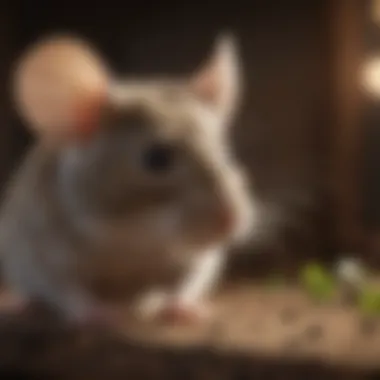Effective Strategies for Catching Mice


Intro
Mice can be a nuisance. They invade homes, gardens, and businesses, creating messes and spreading diseases. Understanding these creatures is essential for effective control methods. By examining traditional traps, humane alternatives, and prevention techniques, one can develop a comprehensive strategy against mouse infestations.
Conducting the right approach to catch mice involves not just the tools used, but also insights into their behaviors and natural instincts. In this article, we will explore several effective strategies that can be employed to manage rodent problems while keeping ethics in mind. This discussion is especially relevant for animal lovers, wildlife enthusiasts, and property owners seeking balance between efficacy and humanity in pest control practices.
Animal Species Profile
Intro to the Animal Species
Mice belong to the family Muridae. They are small, typically nocturnal rodents. Various species exist, including the common house mouse and field mice. Understanding the species involved is crucial for designing an effective pest control strategy.
Physical Characteristics and Appearance
Mice have distinguishing features. They usually possess round bodies with a pointed snout. Their ears are large, and their tails are long and slender. Most common species have fur that ranges in color from gray to brown. Adult mice can weigh around 0.6 to 1 ounce.
Natural Habitat and Distribution
Mice are adaptable animals. They thrive in diverse environments, from urban areas to rural landscapes. Their natural habitats include fields, forests, and even human dwellings. This adaptability enables them to spread quickly and find sources of food.
Behavior and Social Interactions
Mice are social creatures. They often live in groups, which helps them find food and avoid predators. They communicate through squeaks and body language, using scents to mark territories. Their active nature leads them to explore and forage, which often brings them into conflict with humans.
Traditional Traps
Effectiveness of Snap Traps
Snap traps are conventional. They work by using a spring mechanism to quickly kill the mouse. When placed strategically, these traps can be highly effective.
Live Traps
Live traps allow for humane capture. They trap mice without harming them. After capture, mice can be released far away from human dwellings. This is suitable for those with ethical concerns about killing.
Preventive Measures
Sealing Entry Points
Preventing entry is vital. Inspect homes for gaps or holes. Sealing these openings minimizes future infestations.
Food Storage Practices
Keeping food sealed is essential. Mice are attracted to easy sources of food. Use airtight containers for storage. Regularly clean areas where food is prepared or consumed.
Maintaining Cleanliness
Reducing clutter helps. Mice prefer hiding in dark, cluttered spaces. Regular cleaning and organization minimize their opportunities for nesting.
The End
Understanding mice, along with effective catching strategies, is fundamental for controlling their populations. While traditional traps may quickly resolve the issue, humane options and preventive strategies can help manage the problem sustainably. Considering ethical implications is crucial for any pest control approach. By balancing efficacy with humane methods, we can create a safer place for humans and wildlife alike.
Foreword to Mouse Control
Addressing mouse infestations requires a solid understanding of mouse control methods. This article aims to provide insight into various strategies for effectively catching mice, ensuring both humane and efficient approaches are discussed.
Understanding the Mouse Population
Mice are small rodents that adapt well to various environments. Their numbers can grow rapidly, leading to significant challenges in homes and businesses. Understanding their biology, behavior, and social structures is crucial in developing effective control strategies. Mice typically reproduce several times a year, leading to significant population growth under favorable conditions. This high reproductive rate is one reason infestations can escalate quickly.
Moreover, mice have preferences for certain habitats. They tend to inhabit areas close to food sources, making kitchens and storage areas primary targets for their nests. By recognizing these habitats, individuals can better prepare to manage their presence and reduce attractants like food scraps and accessible waste.
The Importance of Effective Control
Implementing effective mouse control is vital not only for health reasons but also for property preservation. Mice can transmit diseases and cause damage to structures and electrical wiring. An effective control plan mitigates these risks.
Moreover, addressing mouse populations in a timely manner can prevent larger infestations from taking hold. Proactive measures, such as identifying entry points and employing strategic trapping, form the foundation for successful mouse control efforts.


Effective mouse control blends the understanding of mouse behavior with practical strategies to prevent infestations before they become overwhelming.
Ensuring a balance between humane and effective methods remains important. This approach not only respects wildlife but also creates a sustainable solution for controlling mouse populations in any environment.
Types of Traps
The selection of traps is a fundamental aspect of mouse control strategies. Different traps come with specific functionalities and advantages, affecting their effectiveness against rodent populations. Selecting the right type of trap is determined by various factors including the level of infestation, the environment where the traps will be placed, and personal ethical considerations regarding animal welfare. Evaluating these options helps address the immediate problem while aligning with longer-term control methods from humane perspectives.
Snap Traps
Snap traps remain one of the most traditional and widely used methods for catching mice. Their simple design consists of a mechanism that quickly kills the mouse upon entering the trap. For many, their effectiveness and immediate results make snap traps appealing. Setting them in areas where mouse activity is noted increases the chances of capture. However, placement is crucial. If not positioned correctly, mice may avoid them altogether.
Several pros exist with snap traps. They are inexpensive, reusable, and can capture multiple mice if strategically placed. Furthermore, they do not require any bait to lure the mouse, as the mechanical action is sufficient when combined with an enticing food source. However, it is essential to handle snap traps with care to avoid any unintended harm to pets or non-target species.
Electric Traps
Electric traps are a more modern approach to mouse control. These devices deliver a quick lethal shock upon contact, resulting in a clean and humane death compared to other methods. Electric traps may be more costly than traditional snap traps, but many consider their efficiency justifies the investment. The risk of injury to non-target wildlife is reduced since these traps are designed to target small rodents exclusively.
The appeal of electric traps lies in their potential for ease of use. They can be set up and operated with minimal maintenance. Many models are designed to provide alerts when a mouse is captured, allowing users to dispose of the carcass effectively. Proper location and baiting are still essential for maximizing effectiveness.
Glue Traps
Glue traps function differently by using a sticky surface to capture mice. While these traps can be easily placed in various locations, they often elicit a debate regarding humane treatment of animals. Once a mouse contacts the glue, it becomes trapped and cannot escape. This leads to a prolonged and distressing death, which raises ethical concerns for many animal lovers.
While glue traps are inexpensive and can catch multiple mice over time, the ethical issues often outweigh these advantages. It is vital to consider an alternative when working toward a humane solution for mouse control. If glue traps must be used, regular inspection is critical to ensure captured mice are dealt with as painlessly as possible.
Catch-and-Release Traps
For those looking for humane ways to remove mice, catch-and-release traps are perhaps the best option. These traps capture mice alive, allowing for their relocation away from homes and properties. While this method is praised by animal rights advocates, it comes with its own challenges.
Catch-and-release traps must be checked frequently to prevent stress and suffering to the captured animals. Additionally, finding a suitable location for releasing the mice is essential, as well as ensuring that they are not simply returned to the same area.
"The method chosen for rodent control should balance efficacy with humane considerations whenever possible."
Utilizing these various traps requires careful selection based on specific circumstances and outcomes desired. A thoughtful approach to managing mouse populations translates into enhanced effectiveness in pest control.
Bait Options for Traps
When dealing with mice, choosing the right bait is crucial for the effectiveness of traps. The type of bait can significantly influence whether the trap will successfully catch a mouse. Bait options need to be enticing enough to attract mice while also being easy to place in various trap designs. Understanding what bait works best can greatly enhance trapping efforts, leading to more efficient mouse control.
A well-chosen bait not only ensures that mice are lured to the traps, but it can also reduce the time and effort needed to manage an infestation. Various factors need to be considered when selecting bait, including the mice's feeding habits, accessibility of the bait, and potential health risks if using certain substances.
Common Baits
Common baits are typically high in protein and fat, making them very appealing to mice. Some widely used baits are:
- Peanut Butter: Its strong aroma and sticky texture make it a popular choice among pest controllers. Mice will often struggle to resist this delicious treat.
- Cheese: Though depicted in various media as the favorite of mice, cheese does not always yield the best results. However, many still use it, especially strong-smelling varieties such as aged cheese.
- Seeds and Nuts: These are natural food sources for mice and can be effective in traps as well. Sunflower seeds, for example, are often seen as irresistible.
- Fruits: Small pieces of dried fruit or fresh fruit can be effective. Raisins or apple slices may work particularly well, especially when mice forage for food.
The effectiveness of these common baits can vary based on the context. Professional pest controllers often recommend rotating different baits to determine which is most effective in particular situations.
Natural Bait Alternatives
For those who lean towards more natural alternatives, several bait options can serve as effective replacements. These baits often prioritize sustainability and reduce chemical exposure. Some noteworthy natural bait alternatives include:
- Oats: Plain oats are a healthy, natural food source for mice and can attract them perfectly.
- Nut Butters: Varieties beyond peanut butter, such as almond or cashew butter, can be enticing for mice due to their rich taste.
- Cooked Grains: Things like corn or pasta may appeal to mice, making them a viable option.
- Insect Larvae: Using dried insects can attract specific species of mice; however, this method may be considered too unconventional for some.
Opting for natural bait alternatives not only encourages a more eco-friendly approach but may also minimize the risk of unwanted chemicals affecting one's living space. As such, it can be beneficial to consider the ethical aspects of the trapping process while still attempting to achieve effective mouse control.
When considering your options for bait, always be aware of the food preferences of the local mouse population and tailor your selection accordingly, making adjustments as necessary.
Humane Mouse Control
Humane mouse control is an essential aspect of effective pest management that seeks to minimize harm to animals while addressing the pressing concern of mouse infestations. As societies evolve, so do attitudes towards animal welfare. Understanding humane methods fosters a sense of responsibility and care for wildlife, aligning with modern ethical standards. This article section focuses on the implications of humane practices in trapping and relocating mice, emphasizing both their benefits and the considerations that accompany such strategies.
Ethical Trapping Methods
Ethical trapping methods are designed to capture mice without causing unnecessary suffering. These traps prioritize the mouse's welfare while allowing for control of the population. Two widely used humane traps are box traps and catch-and-release traps. Box traps can capture multiple mice at once, preventing the need for repeated setting of traps. These traps often employ a bait mechanism that does not harm the mice once inside.


It's crucial to check these traps regularly, ideally every few hours, to minimize stress for the captured mice. Ignoring this aspect can lead to undue suffering, which contradicts the purpose of humane control. The goal is to maintain a balance between managing mouse populations and respecting their life.
Benefits of Ethical Trapping Methods:
- Allows for the removal of mice without terminating them.
- Helps maintain ecological balance by relocating rather than killing.
- Reduces guilt and enhances satisfaction for those who prioritize animal humane treatment.
Incorporating ethical trapping methods into mouse control not only addresses issues effectively but does so in a way that aligns with the values of animal lovers and wildlife enthusiasts.
Relocation Considerations
Relocating trapped mice is often seen as a good solution in humane control. However, this process involves several important considerations. First and foremost, selecting the right location for relocation is critical. It is important to release the mice several miles away from the capture site to prevent them from returning. Additionally, choosing a site that provides sufficient resources—food, shelter, and nesting materials—is vital for their survival.
Another consideration involves the potential impact on local ecosystems. Moving mice into an area with existing populations may disrupt the balance of that ecosystem. This can lead to competition for food and habitat, potentially causing challenges for the native species. Therefore, understanding local wildlife dynamics is paramount.
Moreover, it’s necessary to comply with any regulations regarding wildlife relocation in your area. Some jurisdictions have specific guidelines about how and where to relocate animals, and violating these rules could result in fines and other implications.
"Humane control methods require us to think beyond the immediate problem of mice and consider the broader ecological implications of our actions."
Preventive Measures for Mouse Control
Preventive measures play a crucual role in mouse control as they help to stop infestations before they begin. This approach often saves time, money, and significant stress. By taking proactive actions, homeowners can minimize the risk factors that invite mice into their spaces. Focus on identifying potential entry points and eliminating food sources. It is often more effective to prevent a problem than to deal with one later.
Home Inspections
Regular home inspections are essential for effective mouse control. Begin by closely examining the exterior of the home. Look for small holes or cracks that may serve as entry points. Mice can squeeze through very small openings, so every inch must be checked. Pay attention to areas around pipes, vents, and foundations. Inside, inspect attics, basements, and storage areas. Any signs of droppings or nesting materials should be addressed immediately.
- Check for common areas of entry:
- Foundation cracks
- Holes around pipes
- Gaps in window screens
By conducting thorough inspections, homeowners can not only identify existing problems but also prevent future issues. It is advisable to schedule inspections at least twice a year, especially before winter, when mice are looking for warmth.
Exclusion Techniques
Once entry points are identified, exclusion techniques are essential. Sealing these openings will significantly reduce the chances of mice entering the home. Use materials like steel wool or caulk to fill holes. It is vital to replace any damaged screens on windows and vents. This barrier not only keeps mice out but also helps maintain better energy efficiency in the home.
- Recommended exclusion methods include:
- Sealing holes with caulk
- Installing metal door sweeps
- Using wire mesh for larger gaps
This technique demands attention to detail. Every potential entry point should be considered, even those that seem insignificant. By ensuring that no openings are available, the likelihood of a mouse infestation greatly reduces.
Sanitation Practices
Maintaining cleanliness is a key component of preventative control measures. Mice are attracted to food sources, so proper sanitation practices should be established. This means keeping food sealed and stored away properly. Regularly dispose of trash and keep spaces tidy to limit nesting opportunities.
Some effective sanitation practices include:
- Storing food in airtight containers
- Cleaning up crumbs and spills promptly
- Keeping garbage securely covered and disposed of regularly
The benefits of sanitation extend beyond just mouse control. A cleaner environment is healthier in general. Mice are not only a nuisance but can also pose health risks through contamination. Therefore, implementing these practices yields significant advantages beyond pest control.
In summary, preventive measures are critical in mouse control. Regular inspections, effective exclusion techniques, and rigorous sanitation practices create an environment that discourages mice from entering or nesting within your home.
Utilizing these strategies establishes a proactive approach to maintaining a pest-free environment.
Understanding Mouse Behavior
Understanding mouse behavior is a crucial aspect of implementing effective control strategies. Knowing how mice interact with their environment, their preferences, and habits can significantly enhance trapping success. This understanding helps in matching the right traps and bait to the specific behaviors of the target population, making it easier to address infestations. Moreover, knowledge about mouse behavior assists in developing preventive measures that minimize future encounters with these pests.
Habitat Preferences
Mice tend to favor habitats that provide shelter, warmth, and accessibility to food. Common areas that attract mice include basements, attics, and kitchens. Within a structure, they often seek out locations that offer concealment, such as:
- Nooks and Crannies: Mice can squeeze through very small openings, which makes tight spaces ideal.
- Piles of Clutter: Stacks of boxes or collections of items provide both shelter and potential nesting sites.
- Near Food Sources: Areas close to where food is stored are particularly attractive, such as pantry corners or under kitchen appliances.
By understanding these preferences, one can take proactive measures to eliminate factors that make a home appealing to mice. Regular cleaning, reduced clutter, and securing food sources can deter these creatures from settling in.


Feeding Habits
Mice are opportunistic feeders and have a diverse diet that makes them adaptable in urban and rural settings. They consume various foods, including:
- Grains and Seeds: Commonly found in granaries, gardens, and homes.
- Fruits and Vegetables: Accessible crops or kitchen scraps are tempting to mice.
- Animal Products: While less common, some mice may nibble on meat or dairy if the opportunity arises.
Understanding these feeding habits aids in selecting bait for traps effectively. For instance, peanut butter and sunflower seeds are typically much more effective than cheese, which is often inaccurately perceived as a mouse's favorite food.
"Recognizing the specific habits and preferences of mice is essential for creating an effective strategy for trapping and prevention."
Legal and Ethical Implications
Understanding the legal and ethical implications surrounding mouse control is crucial for effective pest management. As society becomes more aware of animal rights and conservation, the methods used for controlling mouse populations must comply with established laws and reflect humane practices.
In many regions, laws dictate the type of trapping methods that can be employed. Regulations often focus on ensuring that the traps are humane and do not cause unnecessary suffering. By adhering to these laws, individuals and pest control agencies contribute to responsible wildlife management, which is essential for maintaining ecological balance. Moreover, the ethical considerations around pest control methods can significantly impact public perception. In a world that increasingly values ethical practices, using inhumane methods may lead to backlash against individuals or companies employing such strategies.
Another important aspect to consider is how these implications affect relationships with local communities. Engaging in ethical pest control fosters trust with neighbors and community members. It demonstrates a commitment to not harming wildlife unnecessarily while also addressing the concerns of those impacted by infestations. In this context, the combination of legality and ethics serves as a foundation for responsible behavior and practice.
"The balance between pest control and humane treatment of wildlife is a testament to our commitment to ethical responsibilities."
Regulations on Trapping
Regulations on trapping mice vary from one jurisdiction to another. These legal frameworks are designed to ensure the humane treatment of animals while controlling their populations. Specific laws may address the following areas:
- Types of Traps: Many regions have restrictions on the types of traps that can be used. For instance, snap traps may be allowed, while glue traps might be banned due to their inhumane nature.
- Placement: Regulations often dictate where traps can be set, emphasizing safety, particularly in residential areas.
- Monitoring: Some jurisdictions require traps to be checked regularly. This helps reduce the time a trapped animal suffers.
It is important for anyone engaging in mouse control to familiarize themselves with local laws. Failure to comply with regulations can result in fines or legal action. Additionally, some organizations offer guidelines for ethical trapping, which can aid in navigating these regulations while promoting humane practices.
Ethical Considerations in Pest Control
Ethical considerations play a significant role in how pest control is viewed and practiced. With a rise in awareness about animal welfare, the focus has shifted toward minimizing harm to wildlife.
Key ethical considerations include:
- Humane Treatment: The primary goal should always be to use methods that minimize suffering. This can include the use of catch-and-release traps and avoiding poison that causes prolonged pain.
- Necessity vs. Convenience: Assessing whether a pest control method is necessary rather than merely convenient is vital. Ethical pest control should prioritize long-term solutions and prevention over quick fixes.
- Education and Awareness: Informing the community about humane practices in mouse control fosters better understanding and may encourage similar behavior among locals.
Incorporating these ethical practices ensures that the approach to dealing with mouse infestations is not only effective but also aligned with the values of compassion and consideration for living beings. The implications of failing to act ethically can extend beyond legal issues to include damaging one’s reputation within the community.
When to Seek Professional Help
Dealing with a mouse infestation can be a complex issue. While many DIY methods are effective for small problems, there are times when professional intervention becomes necessary. Recognizing the appropriate moment to enlist expert help ensures that the situation is handled effectively. Ignoring the signs of a serious problem can lead to further complications, making it imperative to understand the boundaries of home management versus professional assistance.
Signs of a Serious Infestation
Not all mouse issues escalate to the same level. Specific indicators suggest that the infestation has become serious enough that professional help is required. Key signs include:
- Frequent sightings: Regularly spotting mice during the day can indicate a higher number of rodents than previously thought. Mice are nocturnal by nature, so seeing them when they should be hidden is concerning.
- Damage to property: Evidence of gnaw marks on furniture, wiring, or walls indicates that mice are nesting nearby. This level of destruction often suggests a larger colony.
- Droppings: Finding excessive droppings in various areas of the home signifies that mice are frequently visiting or residing within the space.
- Nests: Identifying nests made from shredded materials, such as paper or fabric, suggests breeding and signaling a serious occupancy.
Recognizing these signs can prevent further escalation of the problem. It is critical to address the situation swiftly, as unchecked infestations can lead to health risks and property damage.
Choosing a Pest Control Service
When it becomes necessary to seek help, selecting the right pest control service is crucial. The effectiveness of the service can be influenced by several factors. Here are considerations for making an informed choice:
- Qualifications and Certifications: Ensure that the company has licensed professionals who understand local laws and regulations regarding pest control.
- Experience: It is beneficial to choose a service with a proven track record in dealing with mouse infestations. Look for reviews and testimonials from prior clients.
- Methods Used: Understanding the company's approach is important. Some may focus on humane traps, while others may use chemical solutions. Ensure their methods align with your ethical considerations.
- Follow-up Services: Consider whether the company offers follow-up services to monitor the effectiveness of their methods and provide additional treatments if necessary.
In summary, determining when to seek professional help can save time and resources. Not all infestations can be managed without expert assistance. Knowing the signs of a serious problem and how to choose the right pest control service will ensure a more effective approach to managing mouse populations.
Culmination and Recommendations
Summary of Effective Methods
In summary, several effective methods have been explored in this article. Key traps like snap traps and electric traps have been noted for their efficiency. Additionally, humane options like catch-and-release traps cater to those who are ethically concerned about pest control.
Common baits such as peanut butter and cheese have consistently proven effective, alongside natural alternatives like sunflower seeds. Preventive strategies, including thorough home inspections, proper sanitation practices, and exclusion techniques, form a holistic approach to mouse control.
All these methods can be integrated to form a fortified strategy against mouse infestations. The objective is to not only address immediate issues but also mitigate potential future problems.
Best Practices for Ongoing Control
The journey does not end with catching mice; ongoing control is crucial to maintain a mouse-free environment. Here are some best practices:
- Regular Inspections: Periodically inspect your home for potential entry points and signs of mice. Early detection can save time and resources.
- Consistent Sanitation: Ensure that food sources are stored properly. Keep kitchens and dining areas clean to reduce allure for mice.
- Educate Household Members: Ensure that everyone in the household understands the importance of pest prevention. Encourage them to immediately report any signs of mice.
- Utilize Multiple Methods: Combine traps with preventive measures. Use traps in high-risk areas while keeping food sealed and inaccessible.
By adopting these best practices, one can foster an environment less inviting to mice. Ongoing commitment to mouse control not only addresses current infestations but also reduces the chances of future problems. Readers should be encouraged to use the strategies presented to create a balanced and ethical approach to mouse management.







